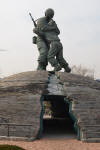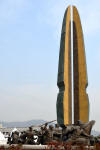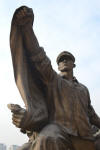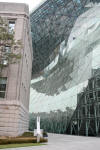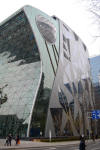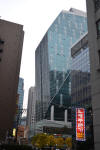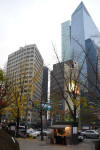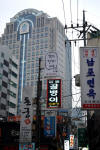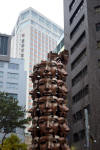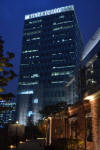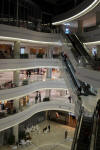Round The World and other travels
A frequent flyer's collection of trip diaries
This is: The Portuguese Connection (2012)
Seoul Discovery
We had breakfast at a local coffee shop that was literally a few steps away from the door of the Courtyard. Although it was after 0800, the shop still seemed to be getting geared up for the day ahead. I was surprised that it wasn't busier on such a bitterly cold morning, where the balmy climes of Hong Kong and Macau already seemed distant in both space and time. After a short stop back at the room, we were ready to take on this rather daunting metropolis, where hardly anyone appeared to speak a word of English.
We walked to the local station, Yeongdeungpo, on
street level. (It later transpired that a parallel subterranean
route was also available.) The fun began in the ticket hall, where
we were confronted with banks of several varieties of ticket
machine. Eventually giving up hope of acquiring anything resembling
a day pass, we settled for single tickets to Anguk, which we were to
reach by taking a Line 1 train to Jongno 3-ga (the '3' was
pronounced 'sam', apparently) followed by a Line 3 train to our
desired destination. We also managed to work out that it was
necessary to overpay slightly as a deposit on the plastic card
tickets, and that the overpayment could be refunded on completion of
the journey by surrendering our used tickets at a 'Deposit Refund
Device'. Simples, as they say - or perhaps not, in this
case.
![]()
Safely delivered to Anguk some considerable time later, we walked the short distance to Jogyesa Buddhist Temple, which looked colourful in the bright morning sunshine. It struck me as unusual, based on my own previous experiences, to see Buddhist monks dressed for near-freezing conditions.
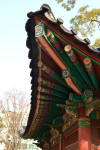 |
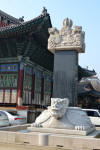 |
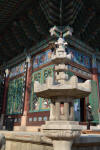 |
 |
 |
LEFT: Bright but cold conditions at Jogyesa Temple |
 |
 |
We then walked to the nearby Bukchon Hanok
Village, one of several traditional Korean villages in the heart of
Seoul. Our endeavours were greatly assisted when we ran into a
couple of young, uniformed 'tourist helpers' (for want of a better
description). Bruce began by asking the young woman for
recommendations on what to see, but she blushed a little, giggled
and pointed at the chest of her male colleague. The young man was
wearing a sign round his neck like some kind of cheap pendant,
bearing the single word 'English'. I guess we should have spotted
that. He turned out to be very friendly and helpful, and drew a
little map of a recommended walking route that would take in the
main sights without delving into every alleyway. Bruce then got some
wide-eyed gasps, quickly followed by broad smiles, when he thanked
the two of them in Korean. Show-off!
![]()
![]()
The village was set into a steep hillside and some attractive views were available from the higher points. The area was very much a living museum; it was clear that people actually resided in the restored properties and we had to be prepared for occasional embellishments drawn from contemporary reality, such as cars backing out of garages or people taking out the garbage.
 |
 |
 |
 |
 |
 |
| ABOVE: Bukchon Hanok Village | |||||
Having made our way back to Anguk Station, we stopped for a welcome and tasty snack at a street food stall, and this proved to be another memorable experience. Our chosen delicacy consisted of small pieces of marinated octopus surrounded by dough, rolled into balls and then deep fried. They were served with a spicy mayo and dried shrimp on top. It may sound a little weird to Western tastes, but we both agreed that it really worked! |
Next, we caught a train for a one-stop hop to Noksapyeong Station, which marks the start of the Itaewon district.
With darkness falling rapidly, matched by the prevailing temperatures, we caught a subway train back to Yeongdeungpo and had a look around the large mall adjacent to the hotel.
